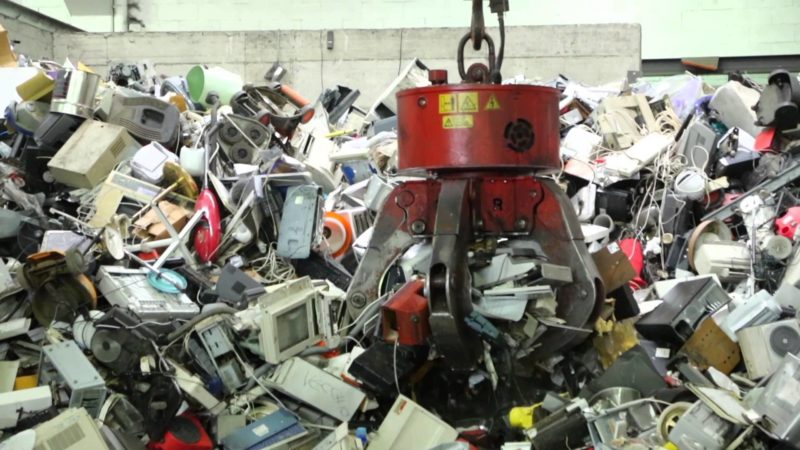Standardised, consolidated data helps to identify recovery potential of secondary raw materials worth billions of euros wasted annually in the EU region

Expert organisations have united to create the world’s first European database of valuable materials available for “urban mining” from scrap vehicles, spent batteries, waste electronic and electrical equipment, and mining wastes.
The Urban Mine Platform created by 17 partners in project ProSUM (Prospecting Secondary Raw Materials in the Urban Mine and Mining Wastes), presents the flows of precious and base metals and critical raw materials in products in use and throughout their journey to end of life.
The database reveals the amount of valuable materials recovered or lost in the EU’s scrap vehicles, batteries, computers, phones, gadgets, appliances and other high tech products discarded annually – roughly 18 million tonnes in all — the weight of three million African elephants.
The EU, Norway and Switzerland generated around 10.5 million tonnes of waste electrical and electronic equipment (WEEE) in 2016 – about 23% of the world total. In addition, two million tonnes of batteries and some seven to eight million tonnes of EU vehicles reach their end-of-life annually. All represent a rich source of secondary critical raw materials (CRMs).
The recently published Global e-Waste Monitor reported that the world’s 44.7 metric tonnes of e-waste alone (not including vehicles) in 2016 contained €55 billion worth of precious metals and other high value materials.
The Urban Mine Platform contains data for elements and materials in high abundance in these waste products, mainly base metals, precious metals, and critical raw materials.
Dynamic charts offer detailed data and market intelligence on:
- The number and type of products placed on the market, in-stock (in use and hibernating), and generated as waste
- The compositions of key components, materials and elements, such as aluminum, copper, gold or neodymium, in batteries, electronic and electrical equipment (EEE), and vehicles
- Waste flows, including amounts collected, estimates for small batteries and EEE in unsorted municipal solid waste, exported used vehicles, as well as the amount of vehicles, batteries and EEE of unknown whereabouts.
- Prospecting Secondary Raw Materials in the Urban Mine
The ProSUM consortium says “urban mining” to recover valuable CRMs from wastes is vital for securing ongoing supplies for manufacturing and limit dependence on non-EU suppliers.
To that end, the project partners created from over 800 source documents and databases “a state of the art knowledge base, using best available data in a harmonised and updateable format, which allows the recycling industry and policymakers to make more informed investment and policy decisions to increase the supply and recycling of secondary raw materials.” It contains “all readily available data on market inputs, stocks in use and hibernated, compositions and waste flows of electrical and electronic equipment (EEE), vehicles and batteries for all EU 28 Member States plus Switzerland and Norway.”
Pascal Leroy, Secretary General of the WEEE Forum, a Brussels-based not-for-profit association and ProSUM project coordinator, states: “Three years in the making, this consolidated database is the world’s first ‘one stop shop’ knowledge data platform on CRMs in waste products – easy to access, structured, comprehensive, peer-reviewed, up-to-date, impartial, broad in scope, standardised and harmonised, and verifiable.”
In its report, the consortium says that “if all of the EEE in stock in households, businesses and public space was shared out between each EU28+2 inhabitant, each person would own close to 44 EEE products plus another 12 (energy saving) lamps and 33 light fittings, which are counted separately. In addition, there is 0.50 vehicle per person in the fleet. In vehicles, electronics and other applications, there are another 40 batteries in stock per person.”
Each EU inhabitant, the report says, would own 250 kg of electronics – 3.5 times the average adult weight – in addition to 17 kg of batteries and almost 600 kg of vehicle.
The report notes that a smartphone contains around 40 different critical raw materials, with a concentration of gold 25 to 30 times that of the richest primary gold ores. Furthermore, miningdiscarded high tech products produces 80% less carbon dioxide emissions per unit of gold compared with primary mining operations.
ProSUM has shown that an increasing number of products contain precious resources such as neodymium (vital for making permanent magnets in motors), indium (used in flat panel displays) and cobalt (used in rechargeable batteries). The Urban Mine Platform makes it possible to see the stocks and flows of these products.
Jaco Huisman of the United Nations University, and ProSUM Scientific Coordinator, states: “Until now, data on such critical raw materials have been produced by a variety of institutions, including government agencies, universities, NGOs, and industry, with the information scattered across various databases in different formats and difficult to compare or aggregate and often representing an outdated snapshot for a certain year only. The ProSUM effort helps remedy that problem, and enables the identification of so-called ‘hotspots’ – the largest stocks of specific materials.”
